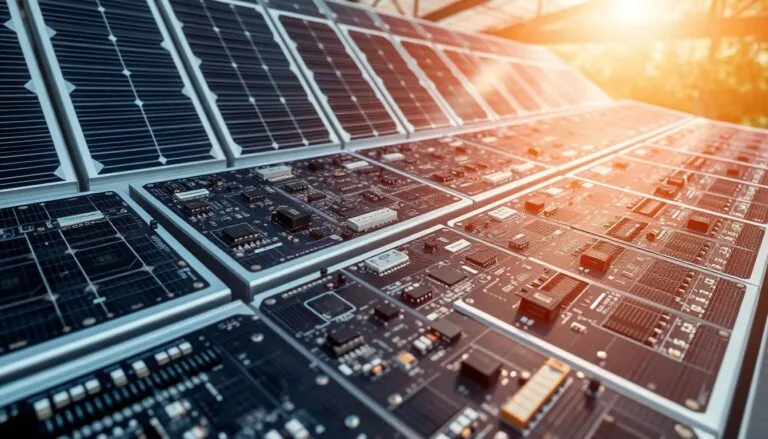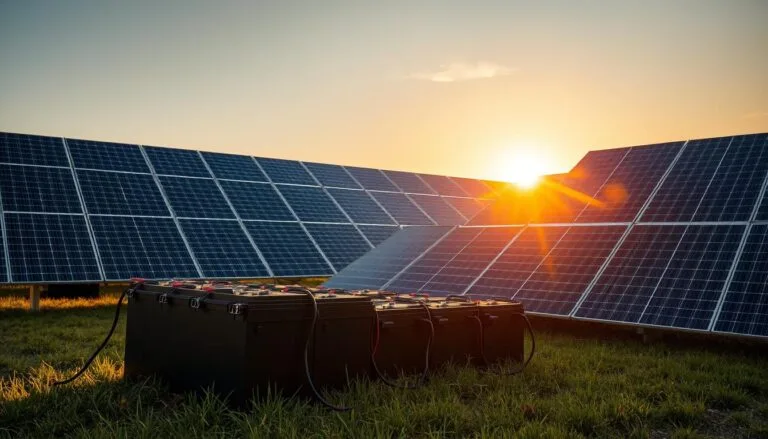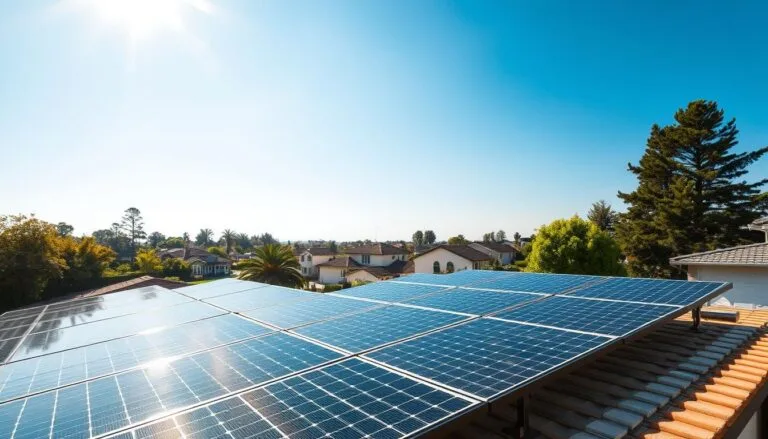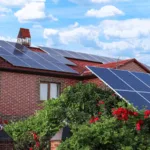Reliable power is the backbone of modern life. As renewable sources vary with sun and wind, capturing output for later use is vital. This keeps electricity available when people need it most.
Battery Energy Storage Systems (BESS) are scaling fast. Advances cut costs, boost efficiency, and aim for recyclable designs. These shifts make clean power more affordable and practical across the United States.
From homes to utilities, smart systems turn intermittent generation into on-demand supply. That creates jobs in manufacturing, installation, and upkeep while lowering carbon emissions.
The promise is clear: better grid resilience, stable electricity, and a cleaner economy that serves communities nationwide.
Key Takeaways
- energy storage solutions.
- Storage transforms intermittent renewables into dependable on‑demand power.
- BESS innovations are cutting costs and improving recyclability.
- Widespread adoption drives job growth and emission reductions.
- Systems scale from rooftop batteries to utility projects.
- Stronger grids mean fewer outages and more resilient communities.
Why Energy Storage Matters Now: From Intermittency to Impact
When clouds gather or the wind calms, communities still need reliable power every hour of the day. That simple gap is the practical problem renewable energy faces in daily life.
Renewables’ challenge: when the sun doesn’t shine and the wind doesn’t blow
There are cloudy days and still nights. Solar and wind output can drop at the very moment demand rises.
Storage as the bridge between production and demand in the power grid
Storage acts as a flexible buffer. It shifts supply across time, absorbs surplus during low load, and discharges at peak demand to keep voltage and frequency steady.
- Protects reliability: delivers power within seconds when frequency falls.
- Reduces curtailment: stores excess instead of wasting clean generation.
- Strengthens resilience: helps communities through heat waves and winter storms.
“IRENA projects stored electrical output must roughly triple by 2030 — from 4.67 TWh to up to 15.72 TWh — to support the renewables build-out.”
Today’s deployments, paired with better forecasting and smart controls, already improve grid performance and boost returns for renewable energy sources.
Defining Energy Storage and Its Expanding Role
Capturing intermittent output turns variable generation into dependable power around the clock. In short, modern systems capture electricity when it is abundant and low-cost, then release it later so homes and businesses have reliable supply any day.
What it means to capture and store energy for use 24/7
Energy storage systems take surplus production and make it available at peak demand. A single device can hold charge, but integrated systems add inverters, controls, and software to manage flow in real time.
From backup to backbone: storage as critical energy infrastructure
Once a backup option, storage now supports grid operations, resilience, and decarbonization goals. Pairing different energy sources with storage improves asset use and cuts curtailment.
- Device vs system: standalone batteries versus orchestrated systems with controls.
- Operational value: store energy during high production and deliver electricity hours later.
- Safety and standards: lifecycle planning and codes ensure dependable community performance.
“Modern systems translate complex operations into simple outcomes: clean, available power any day of the year.”
How Energy Storage Works in the Grid
Quick-response systems step in the moment frequency drifts, holding service steady for homes and industry. They charge when supply outpaces consumption and discharge within seconds when demand spikes.
Frequency regulation: charging during surplus, discharging within seconds
When grid frequency falls because demand rises, these devices inject power almost instantly to lift frequency back to standard.
When frequency climbs due to low demand, they absorb excess by charging.
Balancing supply and demand to stabilize systems
Controls and inverters translate operator signals into precise actions. That enables services like fast frequency response and ramping support.
- Fast action closes the gap between shifting supply and demand in real time.
- Coordinating multiple systems across regions creates a pooled stabilizing effect.
- These services firm renewables, cut curtailment, and add revenue streams for project owners.
“Fast-acting units are a key tool for reliable, clean electricity and a resilient power grid.”
Types of Energy Storage Systems and Technologies
A variety of platforms now lets utilities shape output from seconds to many hours. Different types meet distinct roles: fast frequency response, multi-hour firming, and long-duration grid support.
Battery Energy Storage Systems (BESS): the workhorse
BESS scale from rooftop arrays to utility fleets. They pair with wind and solar to deliver reliable output and help cut curtailment.
Lithium‑ion: performance and circularity
Lithium‑ion dominates because of high round‑trip efficiency and energy density. Costs keep falling while manufacturers push design‑to‑recycle and safer chemistries.
Flow batteries: long‑duration potential
Flow units use modular tanks and offer predictable multi‑hour discharge. That makes them ideal where duration and cycle life matter more than compactness.
Beyond lithium: emerging chemistries
New options—sodium, zinc, and metal‑air—target specific cost, safety, or duration niches. Advances in battery management and system design shape lifespan and total cost.
“IRENA projects stored electrical output must roughly triple by 2030 — from 4.67 TWh to up to 15.72 TWh — to support the renewables build‑out.”
Choosing the right chemistry and system design aligns performance with use case, whether for vehicles, behind‑the‑meter installs, or utility grids.
Learn more about practical deployments and project design at energy storage systems.
Energy Storage Solutions for Every Application
Practical deployments now match the right hardware to each use case, from city substations to neighborhood rooftops.
Utility-scale systems for the power grid and ancillary services
Large projects stabilize the power grid by providing peak shaving, load shifting, and fast frequency response.
They help integrate more renewables while creating jobs in manufacturing, installation, and maintenance.
Behind-the-meter options for homes and businesses
Behind‑meter units cut bills and raise resilience. Owners use them for backup power and demand charge management.
Standardized systems and streamlined installation make adoption faster across the United States.
Electric vehicles and the evolving role of batteries
Vehicles bring new flexibility. Managed charging and bidirectional features let fleets act as mobile assets.
A single storage system can be reconfigured over its lifetime to serve multiple uses, maximizing benefits and grid value.
- Applications span: utility, commercial, and residential markets.
- Services delivered: reliability, cost control, and emissions reduction.
- Installation ease: modular designs and clear standards speed deployment.
U.S. Market Momentum and Policy Tailwinds
A wave of federal support is moving projects from the drawing board to full commercial build‑out.
The market jumped past $1.6 billion in 2020 and Statista projects it near $8.2 billion by 2025. That rise signals strong demand for modern battery systems across utilities, commercial fleets, and homes.
IRA impact and capacity outlook
The Inflation Reduction Act provides incentives that spur private investment and domestic manufacturing.
DOE estimates shifted projections from roughly 50 GW before the IRA to more than 200 GW by 2040. That seismic change shows how policy can accelerate adoption and innovation.
Scaling renewables and adjacent trends
Integration now spans wind, solar, hydro, geothermal, and marine resources. This broad mix gives the grid more flexibility and higher confidence when meeting peak demand.
- Ripple effects: more projects, stronger supply chains, and improved performance.
- Vehicles and fleets: managed charging and peak management boost value for systems.
- Planning year: developers align workforce and capital around clear incentives.
“Policy certainty is the catalyst that turns potential into deployed capacity and jobs.”
Costs, Installation, and Benefits That Scale
Manufacturing scale and smarter designs are driving rapid price declines and wider adoption nationwide. Large-scale production cuts per-unit cost and raises consistency. Standardized modules and assembly lines speed delivery and improve quality.
Installation pathways now match project size. Home retrofits follow clear permit steps and standard mounts. Commercial installs use modular racks to shorten site work.
Utility deployments rely on preengineered containers and grid-grade controls to reduce on-site time. Thoughtful siting, interconnection planning, and permitting clear the path to faster commissioning.
Project economics and operational value
Owners boost returns by stacking services and optimizing dispatch to meet peak demand. That improves payback while supporting reliable power and grid security.
Operational benefits include near-zero CO2 during use, better power quality, and new services like frequency and black-start support. These add resilience for communities.
- Scale lowers cost and raises performance.
- Clear installation routes speed time to value.
- Lifecycle planning extends project returns across many day-to-day cycles.
“Standardized designs and skilled installers turn complex projects into predictable community assets.”
Local jobs grow in manufacturing, installation, and long-term upkeep. That economic lift pairs with environmental benefits and stronger grids for the long term. Learn more about practical deployments at battery energy storage systems.
The Strategic Role of energy storage solutions in the Energy Transition
New modular assets supply crucial reserves and restore grids after outages with speed and precision. These devices now deliver a suite of ancillary services that utilities depend on for secure daily operations.
Ancillary services: static reserve, frequency, voltage, and black start
Frequency response corrects imbalances within seconds. Voltage support keeps local networks stable. Static reserve stands ready for unexpected loss of supply.
Black start capability lets operators restart sections of the power grid without fossil fuel plants. Together, these services reduce dependence on older thermal generators.
From fossil fuel dependence to green energy reliability
By providing multiple services from a single asset, projects stack revenue streams and improve economics. Multi-use systems firm up renewable energy output so supply matches demand as weather and loads change.
Communities benefit through cleaner air, fewer outages, and a stronger grid. Achieving this at scale depends on standards, rigorous testing, and operator training so services arrive reliably and safely.
“Modern fast-acting assets replace slow, fuel-based flexibility with clean, predictable performance.”
- Grid fortification: ancillary services strengthen reliability and reduce fossil fuel use.
- Better returns: stacking services improves project cash flow and lifespan.
- Operational readiness: standards and training ensure consistent regional delivery.
Conclusion
,Today’s toolkit pairs fast-response units with longer-duration designs to make renewables dependable every hour. Modern battery and flow platforms transform variable wind and solar into steady electricity for homes, businesses, fleets, and grid operators.
Practical gains follow clear policy, manufacturing scale, and smarter project design. Choose the right energy storage systems for your application by weighing performance, lifecycle, and costs. With targeted incentives and growing market momentum, wider deployment will be faster, safer, and more affordable nationwide. The result: renewables that behave like baseload power and communities that can count on clean, reliable service for years to come.


























